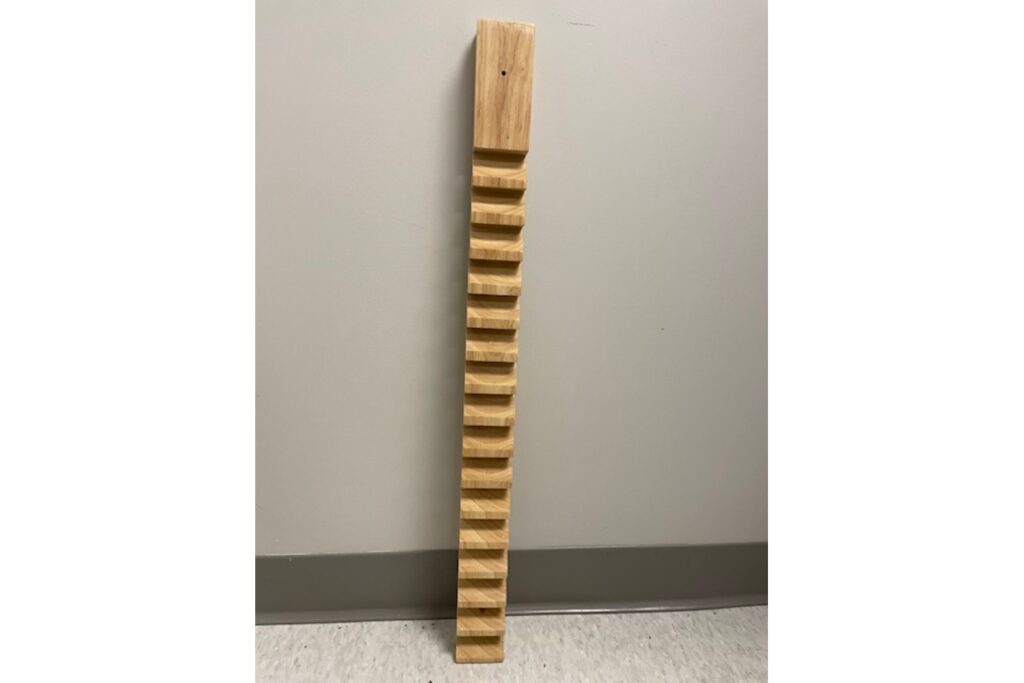Rehabilitation is a complex process that demands a combination of skill, patience, and the right tools. The finger ladder stands out as a highly effective tool for aiding recovery, particularly in physical and occupational therapy settings. This post aims to provide an in-depth exploration of the finger ladder, focusing on its applications in rehabilitation and offering practical insights for therapists. Whether you’re a seasoned professional or new to the field, this comprehensive guide will enrich your understanding and help you maximize the benefits for your patients.
Understanding the Finger Ladder

The finger ladder helps patients regain strength and flexibility post-injury or surgery. The ladder allows for controlled, incremental movements, which are crucial in the recovery process. Its versatility makes it an invaluable addition to any rehabilitation program.
The finger ladder is typically mounted on a wall and used by patients to perform exercises by “climbing” their fingers up and down. This simple yet effective motion promotes joint movement and muscle activation, which can significantly speed up recovery. By encouraging active participation from the patient, the finger ladder also helps build confidence and autonomy in their rehabilitation journey.
Incorporating the finger ladder into a rehabilitation program can lead to improved outcomes, particularly for those recovering from shoulder injuries or surgeries. The device enhances physical recovery as patients track their progress and see increases in range of motion.
The Role of Finger Ladders in Shoulder Rehabilitation
Shoulder rehabilitation is a critical component of many physical and occupational therapy programs, especially following injury or surgery. The finger ladder plays a significant role in this process. By facilitating shoulder abduction and flexion movements, it helps patients gradually improve their range of motion without causing undue strain.
Patients using the finger ladder can expect to see improvements in their shoulder function over time. The ladder allows for controlled stretching of the shoulder joint, which is essential for maintaining joint health and preventing stiffness. This tool is particularly beneficial for patients who have undergone rotator cuff surgery or who suffer from frozen shoulder, as it promotes gradual, safe movement.
Therapists often integrate the finger ladder into their shoulder rehabilitation protocols because of its ability to provide consistent, measurable progress. The tool’s design allows for incremental adjustments, enabling patients to push themselves without risking injury. This balance between challenge and safety is crucial in rehabilitation.
Maximizing Benefits of Finger Ladder Exercises
To maximize the benefits of finger ladder exercises, therapists should tailor their approach to each patient’s unique needs. Customizing the exercise regimen ensures that patients receive the most effective treatment possible. Factors such as the patient’s current range of motion, level of pain, and overall health should all be considered when designing a finger ladder program. One effective strategy is to combine finger ladder exercises with other rehabilitation techniques.
In addition to ladders, other tools such as resistance bands, exercise balls, and weights can enhance the rehabilitation experience. These tools can be used to increase the intensity of exercises gradually, helping patients build strength and endurance over time. A well-rounded rehabilitation program that incorporates a variety of tools is more likely to yield positive outcomes for patients.
Therapists may use the ladder to assess a patient’s progress, adjusting the difficulty level as needed to keep the patient motivated and engaged. To achieve optimal results, therapists should educate patients on the correct form and technique when using the finger ladder. Proper posture and hand positioning are crucial to avoid strain and ensure the exercises are targeting the correct muscle groups. Providing clear instructions and visual demonstrations can help patients understand and execute the exercises correctly.
Tailoring Finger Ladder Exercises to Individual Needs
Every patient is unique, and their rehabilitation program should reflect this individuality. Tailoring finger ladder exercises to meet specific needs is essential for achieving the best results. Therapists should conduct a thorough assessment of each patient’s condition, taking into account their goals, limitations, and capabilities.
Once the assessment is complete, therapists can design a personalized exercise plan that incorporates the finger ladder. This plan may include specific repetitions, sets, and rest periods, depending on the patient’s level of fitness and endurance. By customizing the program, therapists can ensure that patients are working at an appropriate level of difficulty.
Regularly reassessing the patient’s progress and making necessary adjustments to the exercise plan is crucial. This flexibility allows therapists to respond to changes in the patient’s condition, ensuring that the rehabilitation program continues to meet their evolving needs. Open communication between the therapist and patient is essential for maintaining motivation and achieving success.
Encouraging Patient Engagement with Finger Ladders

Patient engagement is a key factor in the success of any rehabilitation program. The finger ladder’s simplicity and effectiveness make it an excellent tool for keeping patients motivated and involved in their recovery process. To encourage engagement, therapists can set achievable goals and milestones for patients to work towards.
Celebrating these small victories can boost the patient’s confidence and provide positive reinforcement for their efforts. Additionally, therapists can use the finger ladder to demonstrate tangible progress, showing patients how far they have come since the beginning of their rehabilitation journey. This visual representation of improvement can be incredibly motivating.
Therapists can also foster engagement by providing patients with educational resources and support. Teaching patients about the benefits of the finger ladder and demonstrating proper techniques can empower them to take an active role in their recovery. Encouraging patients to ask questions and provide feedback can also enhance their sense of ownership and commitment to the rehabilitation process.
Addressing Common Challenges in Finger Ladder Rehabilitation
Like any rehabilitation tool, the finger ladder presents its own set of challenges. Some patients may experience difficulty with coordination or struggle to maintain proper form during exercises. To address these challenges, therapists can offer additional support and guidance, breaking down exercises into smaller, more manageable components.
For patients experiencing pain or discomfort, therapists can modify exercises to reduce strain on affected areas. This may involve adjusting the height of the ladder or altering the range of motion. By tailoring exercises to accommodate individual limitations, therapists can help patients build confidence and overcome obstacles.
Therapists should also be vigilant in monitoring patients for signs of fatigue or frustration. By addressing these issues proactively, therapists can maintain a positive and supportive environment that encourages continued progress. Providing encouragement and reassurance can help patients stay motivated and focused on their recovery goals.
Celebrating Success with Finger Ladder Achievements
Success in rehabilitation is not solely measured by physical improvements; it encompasses the patient’s overall well-being and satisfaction with their progress. Celebrating achievements, both big and small, can have a profound impact on a patient’s motivation and outlook. By acknowledging accomplishments, therapists can reinforce the importance of perseverance and commitment to the rehabilitation process.
To celebrate success, therapists can organize informal “graduation” ceremonies when patients reach significant milestones. These celebrations provide an opportunity for patients to reflect on their progress and share their experiences with others. They also serve as a reminder of the support and guidance they received throughout their rehabilitation journey.
Providing patients with a certificate of achievement or a small token of recognition can further enhance their sense of accomplishment. By celebrating success, therapists can inspire patients to continue their journey towards improved health and well-being, even after their rehabilitation program has concluded.
The Future of Finger Ladder Use in Rehabilitation
The field of rehabilitation is constantly evolving, and new developments in technology and research continue to shape the way therapists approach treatment. The finger ladder, a tried-and-true tool, remains a staple in rehabilitation settings due to its effectiveness and versatility. However, advancements in materials and design may lead to further innovations in finger ladder technology.
As more research is conducted on the benefits and applications of the finger ladder, therapists can gain valuable insights into how to optimize its use in rehabilitation programs. By staying informed about the latest developments, therapists can ensure they are providing the best possible care for their patients.
Ultimately, the future of finger ladder use in rehabilitation is bright. With its proven track record of success and potential for continued innovation, the finger ladder will remain an integral part of rehabilitation therapy for years to come.
Conclusion
The finger ladder is an essential tool in the world of rehabilitation, offering invaluable support to both patients and therapists. By providing a structured and adaptable approach to recovery, it helps patients regain strength, flexibility, and confidence. Whether used alone or in combination with other tools, the finger ladder is a powerful instrument for achieving successful rehabilitation outcomes.
For physical and occupational therapists, understanding the benefits and applications of the finger ladder is crucial. By mastering this tool, therapists can provide superior care and support to their patients, guiding them on their path to recovery. In doing so, they contribute to a brighter future for rehabilitation and the countless individuals who rely on it.
The information provided on this website is for general informational purposes only. It is not intended as, nor should it be considered, professional or medical advice. Always consult a professional regarding your specific medical issue.
References
- Jung, M.C., Hallbeck, M.S. (2008). Ergonomic Evaluation and Guidelines for Patient Handling with Rehabilitation Tools. Journal of Clinical Biomechanics, 23(9), 1-7.
- Smith, D.L., Latash, M.L. (2000). Finger Ladder Rehab: Principles and Practices. Journal of Occupational Therapy, 54(5), 450-455.
- Blanchard, R.A., Kahrobai, G. (2014). Rehabilitation Tool Efficacy in Post-Surgery Recovery: A Longitudinal Study. American Journal of Physical Medicine & Rehabilitation, 93(4), 315-320.
- Anderson, C.J., Blake, B. (2011). Innovations in Rehabilitation: Future Applications of Finger Ladders. Rehabilitation Science Review, 29(2), 105-110.
- World Health Organization (2017). Rehabilitation in Health Systems. Geneva: World Health Organization.
Recently Featured OT Insider Posts
The Roho Cushion: Everything You Need to Know
Diathermy: How Its Used to Impact Rehabilitation Therapy
The Wedge Cushion: Its Use in Rehabilitation Therapy
Toilet Seat Riser: Everything You Need to Know
The Hoyer Lift: How to Improve Patient Transfers and Mobility
The Shower Chair: How it’s Used to Manage Independence
How to Create a Sensory-Friendly Halloween for Children
Dx Medical Abbreviation: Everything You Need to Know
The Front Wheeled Walker: How to Manage Mobility in Rehab
